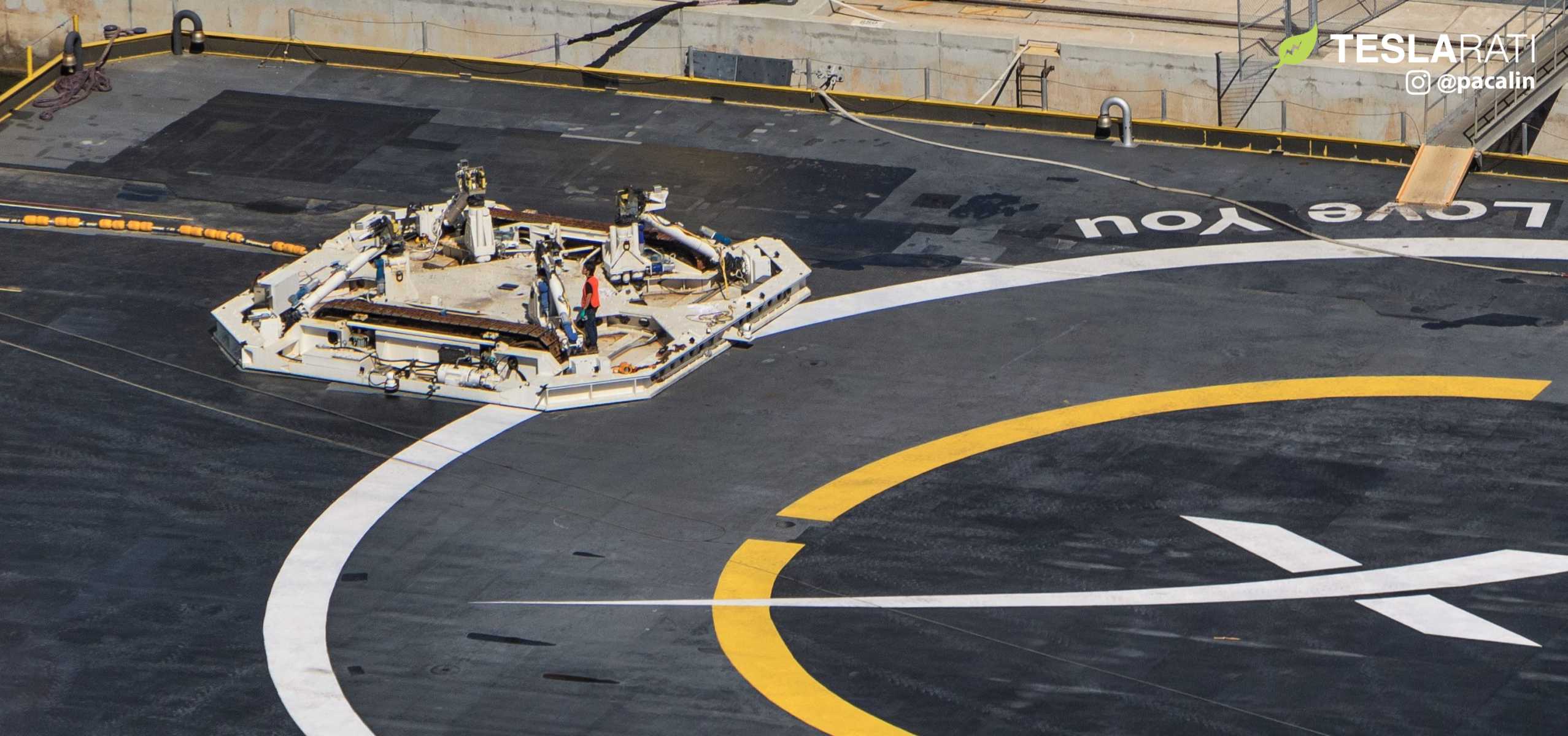
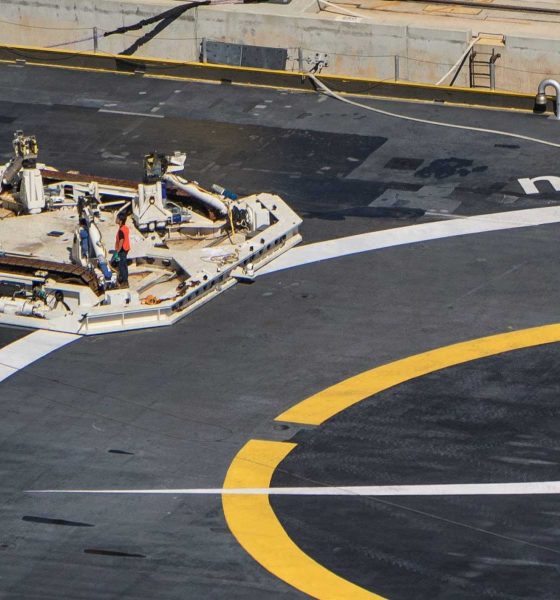
News
SpaceX eyes major drone ship fleet upgrades and a new rocket recovery robot
SpaceX has kicked off a series of major upgrades planned for its East Coast fleet of drone ships, centered around Just Read The Instructions (JRTI) and most recently culminating in the apparent fabrication of a second tank-like rocket recovery robot.
Back in Q4 2019, West Coast drone ship JRTI officially departed the Port of Los Angeles berth it operated out of for 3+ years — traversing the Panama Canal, making a weeks-long pit-stop in a Louisiana port, and ultimately arriving at Port Canaveral on December 11th. The modified barge spent more than a month relatively untouched – as was the somewhat mysterious cargo it had brought with it from the Gulf Coast – before SpaceX began JRTI’s long-awaited upgrades around a month ago.
For almost half a year, it’s looked like that SpaceX would move its West Coast drone ship to Florida after the company’s Vandenberg Air Force Base (VAFB) pad entered a major lull in launch activities in early 2019. Aside from one launch in June 2019, SpaceX’s West Coast pad has remained unused and that isn’t expected to change anytime soon. With Cape Canaveral potential reopening its dormant polar launch corridor just weeks from now, it’s entirely possible that SpaceX will be able to perform all of its planned launches from Florida alone for at least the next 6-12 months. Targeting more than 30 East Coast launches in 2020 alone, SpaceX could also benefit from at least one additional drone ship to continue high-volume Falcon booster recoveries without ship availability becoming a major launch constraint. Thankfully, JRTI may be the perfect solution.
Informally known as ‘Octagrabber’, a reference to the robot’s primary function, SpaceX has been using the only operational instance of the vehicle on drone ship Of Course I Still Love You (OCISLY) for more than two years, beginning in 2017. While far from autonomous, Octagrabber helps SpaceX’s maritime rocket recovery team minimize the risks workers are subjected to and gives the company a bit more flexibility to attempt Falcon booster landings in less-than-pristine ocean weather.
While Falcon boosters are relatively stable once landed, thanks to the vast majority of their empty mass being concentrated around their nine Merlin 1D engines, even moderate waves can cause them to slip and slide around the drone ship deck.
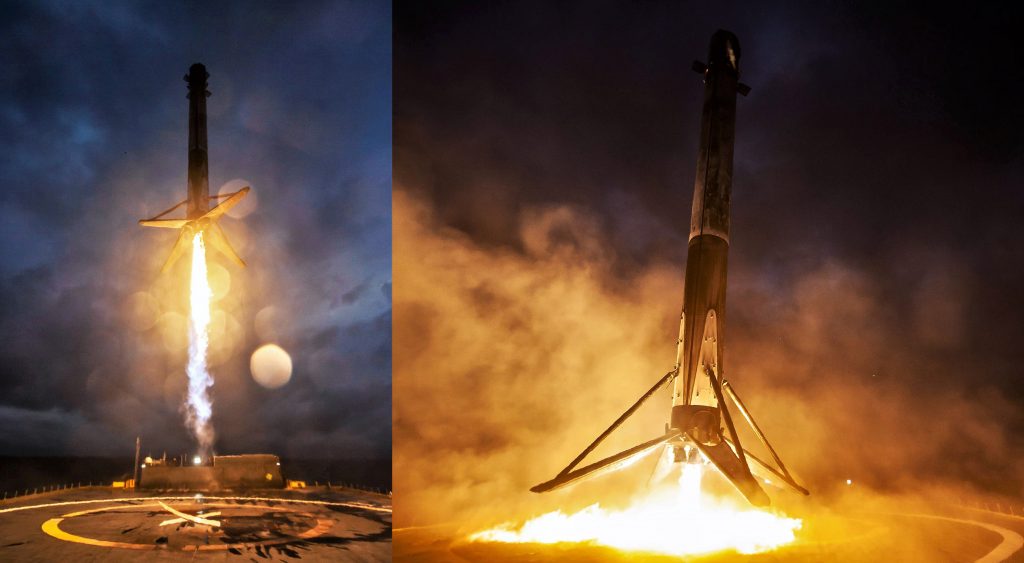
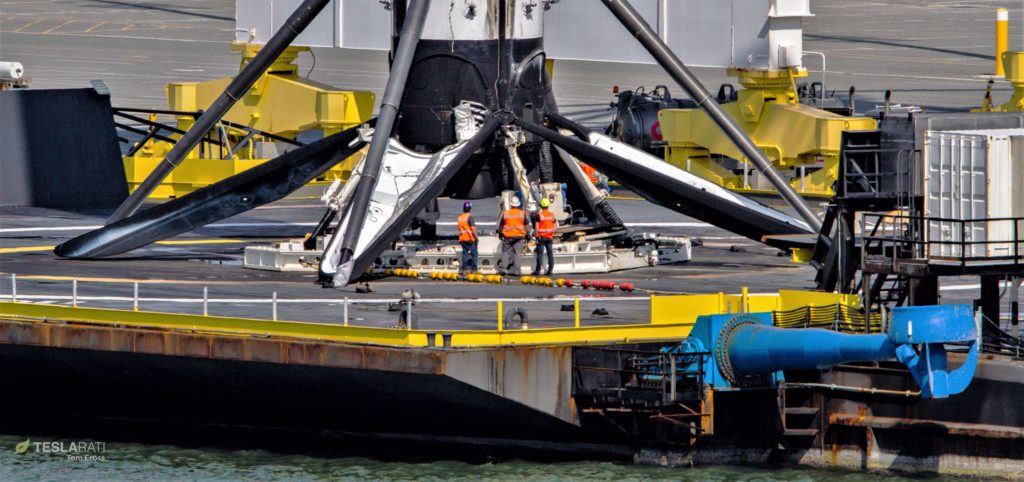
In fact, the best operational demonstration of the value of Octagrabber-style recovery robots came after SpaceX’s historic Falcon Heavy triple-booster recovery in April 2019 – the first time all three of the rocket’s first stage boosters successfully landed after liftoff. As it turns out, thanks to moderate hardware differences between Falcon Heavy center core boosters and normal Falcon 9 boosters, OCISLY’s Octagrabber robot did not have the attachment mechanisms needed to ‘grab’ the center core (B1055, in this case). In theory, this could be a non-issue but the drone ship unfortunately ran into high seas, making its deck to pitch and tilt and ultimately causing to B1055 to tip over, breaking in half and effectively destroyed the booster.
With Octagrabber robots, drone ships should almost never lose recovered boosters because of high seas (within reason). As such, it should come as no surprise at all that SpaceX is building a new recovery robot for drone ship JRTI – the newest addition to its Florida fleet.
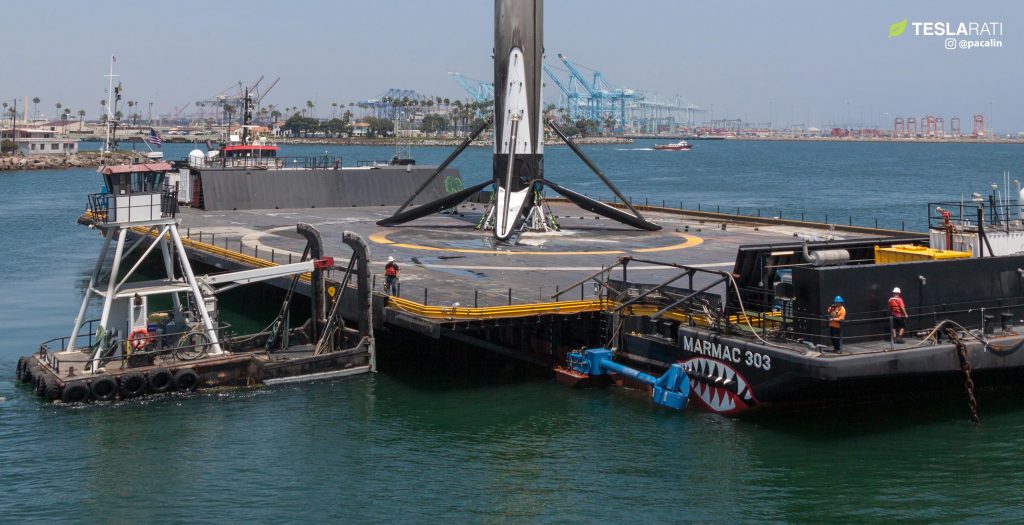
Aside from the discovery of a second Octagrabber being built at SpaceX’s former East Coast Starship factory, the nature of other upgrades planned for drone ship JRTI are more mysterious. For several months, the rocket landing platform has had almost a dozen massive generators and new thruster pods stored on its deck, seemingly waiting on an unknown impetus for their installation. In recent weeks, visible work to prepare the new hardware for installation has begun.
Notably, the thrusters and power supplies that seem destined for installation on JRTI would make for a dramatic upgrade, potentially giving the drone ship more power than the tug boats that must currently tender and tow them to landing zones. In other words, that’s a complicated way of saying that SpaceX may be trying to make drone ship JRTI almost entirely independent of contracted tugboats, potentially simplifying and lowering the cost of booster recoveries.
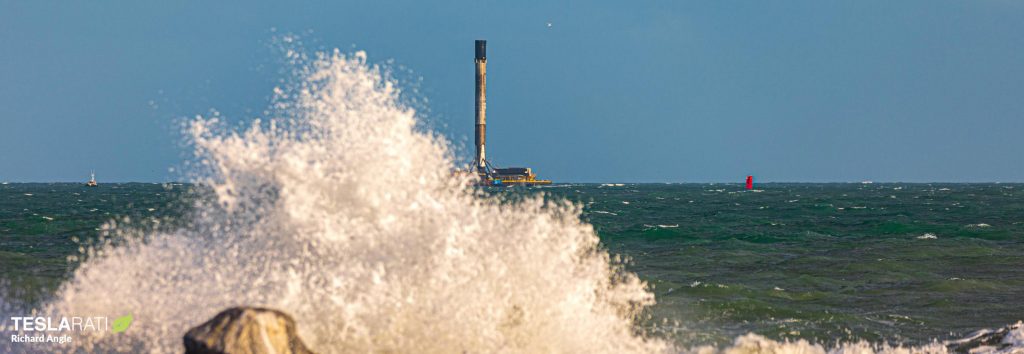
While less likely, it’s also possible that SpaceX is finally in a position to fully realize the “autonomous” namesake of its autonomous spaceport drone ships (ASDS), with high-powered thrusters potentially giving JRTI the ability to leave port, cruise to Atlantic Ocean landing zones, deploy an Octagrabber, and return to port with a booster – all without humans in the loop. That capability is likely still on the horizon but powerful thrusters and generators would bring port-to-port drone ship autonomy within SpaceX’s grasp in the near future.
Check out Teslarati’s Marketplace! We offer Tesla accessories, including for the Tesla Cybertruck and Tesla Model 3.

News
Tesla removes Safety Monitors, begins fully autonomous Robotaxi testing
This development, in terms of the Robotaxi program, is massive. Tesla has been working incredibly hard to expand its fleet of Robotaxi vehicles to accommodate the considerable demand it has experienced for the platform.
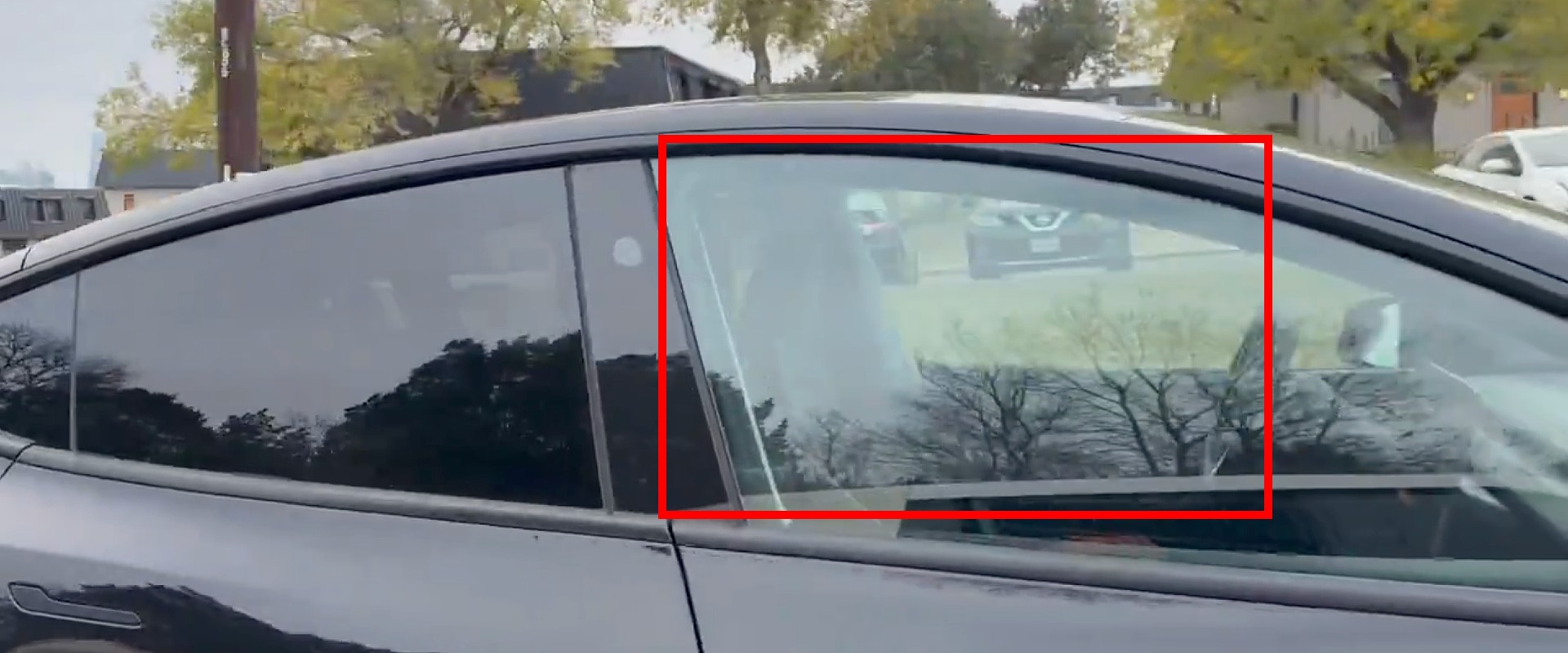
Tesla has started Robotaxi testing in Austin, Texas, without any vehicle occupants, the company’s CEO Elon Musk confirmed on Sunday. Two Tesla Model Y Robotaxi units were spotted in Austin traveling on public roads with nobody in the car.
The testing phase begins just a week after Musk confirmed that Tesla would be removing Safety Monitors from its vehicles “within the next three weeks.” Tesla has been working to initiate driverless rides by the end of the year since the Robotaxi fleet was launched back in June.
Two units were spotted, with the first being seen from the side and clearly showing no human beings inside the cabin of the Model Y Robotaxi:
A Tesla without a driver was spotted traveling on public roads! pic.twitter.com/ZLbduf4cKa
— TESLARATI (@Teslarati) December 14, 2025
Another unit, which is the same color but was confirmed as a different vehicle, was spotted just a few moments later:
NEWS: A second Tesla Model Y Robotaxi running FSD Unsupervised has just been spotted driving itself on public roads in Austin, Texas, with no one in the front seats.
This is a different car from the one spotted earlier. They have different license plates.
h/t @Mandablorian https://t.co/5URYsUGyD0 pic.twitter.com/CIUi4mXi33
— Sawyer Merritt (@SawyerMerritt) December 14, 2025
The two units are traveling in the general vicinity of the South Congress and Dawson neighborhoods of downtown Austin. These are located on the southside of the city.
This development, in terms of the Robotaxi program, is massive. Tesla has been working incredibly hard to expand its fleet of Robotaxi vehicles to accommodate the considerable demand it has experienced for the platform.
However, the main focus of the Robotaxi program since its launch in the Summer was to remove Safety Monitors and initiate completely driverless rides. This effort is close to becoming a reality, and the efforts of the company are coming to fruition.
Testing is underway with no occupants in the car
— Elon Musk (@elonmusk) December 14, 2025
It is a drastic step in the company’s trek for self-driving technology, as it plans to expand it to passenger vehicles in the coming years. Tesla owners have plenty of experience with the Full Self-Driving suite, which is not fully autonomous, but is consistently ranked among the best-performing platforms in the world.
News
Tesla refines Full Self-Driving, latest update impresses where it last came up short
We were able to go out and test it pretty extensively on Saturday, and the changes Tesla made from the previous version were incredibly impressive, especially considering it seemed to excel where it last came up short.

Tesla released Full Self-Driving v14.2.1.25 on Friday night to Early Access Program (EAP) members. It came as a surprise, as it was paired with the release of the Holiday Update.
We were able to go out and test it pretty extensively on Saturday, and the changes Tesla made from the previous version were incredibly impressive, especially considering it seemed to excel where it last came up short.
Tesla supplements Holiday Update by sneaking in new Full Self-Driving version
With Tesla Full Self-Driving v14.2.1, there were some serious regressions. Speed Profiles were overtinkered with, causing some modes to behave in a strange manner. Hurry Mode was the most evident, as it refused to go more than 10 MPH over the speed limit on freeways.
It would routinely hold up traffic at this speed, and flipping it into Mad Max mode was sort of over the top. Hurry is what I use most frequently, and it had become somewhat unusable with v14.2.1.
It seemed as if Speed Profiles should be more associated with both passing and lane-changing frequency. Capping speeds does not help as it can impede the flow of traffic. When FSD travels at the speed of other traffic, it is much more effective and less disruptive.
With v14.2.1.25, there were three noticeable changes that improved its performance significantly: Speed Profile refinements, lane change confidence, and Speed Limit recognition.
🚨 Many of you asked us to test highway driving with Tesla Full Self-Driving v14.2.1.25. Here’s what we noticed:
✅ Speed Profiles are significantly improved. Hurry Mode is no longer capped at 10 MPH over the speed limit, and now travels with the flow of traffic. This is much… pic.twitter.com/48ZCGbW0JO
— TESLARATI (@Teslarati) December 13, 2025
Speed Profile Refinement
Speed Profiles have been significantly improved. Hurry Mode is no longer capped at 10 MPH over the speed limit and now travels with the flow of traffic. This is much more comfortable during highway operation, and I was not required to intervene at any point.
With v14.2.1, I was sometimes assisting it with lane changes, and felt it was in the wrong place at the wrong time more frequently than ever before.
However, this was one of the best-performing FSD versions in recent memory, and I really did not have any complaints on the highway. Speed, maneuvering, lane switching, routing, and aggressiveness were all perfect.
Lane Changes
v14.2.1 had a tendency to be a little more timid when changing lanes, which was sort of frustrating at times. When the car decides to change lanes and turn on its signal, it needs to pull the trigger and change lanes.
It also changed lanes at extremely unnecessary times, which was a real frustration.
There were no issues today on v14.2.1.25; lane changes were super confident, executed at the correct time, and in the correct fashion. It made good decisions on when to get into the right lane when proceeding toward its exit.
It was one of the first times in a while that I did not feel as if I needed to nudge it to change lanes. I was very impressed.
Speed Limit Recognition
So, this is a complex issue. With v14.2.1, there were many times when it would see a Speed Limit sign that was not meant for the car (one catered for tractor trailers, for example) or even a route sign, and it would incorrectly adjust the speed. It did this on the highway several times, mistaking a Route 30 sign for a 30 MPH sign, then beginning to decelerate from 55 MPH to 30 MPH on the highway.
This required an intervention. I also had an issue leaving a drive-thru Christmas lights display, where the owners of the private property had a 15 MPH sign posted nearly every 200 yards for about a mile and a half.
The car identified it as a 55 MPH sign and sped up significantly. This caused an intervention, and I had to drive manually.
It seems like FSD v14.2.1.25 is now less reliant on the signage (maybe because it was incorrectly labeling it) and more reliant on map data or the behavior of nearby traffic.
A good example was on the highway today: despite the car reading that Route 30 sign and the Speed Limit sign on the center screen reading 30 MPH, the car did not decelerate. It continued at the same speed, but I’m not sure if that’s because of traffic or map data:
🚨 We listened to and read a lot of you who had a complaint of Tesla Full Self-Driving v14.2.1 incorrectly reading Speed Limit signs
This appears to be resolved in v14.2.1.25.
Here’s a breakdown: pic.twitter.com/TEP03xrMbt
— TESLARATI (@Teslarati) December 13, 2025
A Lone Complaint
Tesla has said future updates will include parking improvements, and I’m really anxious for them, because parking is not great. I’ve had some real issues with it over the past couple of months.
Today was no different:
🚨 My lone complaint with my drive on Tesla FSD v14.2.1.25 was this strange parking instance.
FSD swung out wide to the left to pull into this spot and this is where it seemed to be stumped. I gave it about 10 seconds after the car just stopped moving for it to make some… https://t.co/ZEkhTHOihG pic.twitter.com/TRemXu5DLf
— TESLARATI (@Teslarati) December 13, 2025
Full Self-Driving v14.2.1.25 is really a massive improvement over past versions, and it seems apparent that Tesla took its time with fixing the bugs, especially with highway operation on v14.2.1.
News
Tesla hints at Starlink integration with recent patent
“By employing polymer blends, some examples enable RF transmission from all the modules to satellites and other communication devices both inside and outside the vehicle.”

Tesla hinted at a potential Starlink internet terminal integration within its vehicles in a recent patent, which describes a vehicle roof assembly with integrated radio frequency (RF) transparency.
The patent, which is Pub. No U.S. 2025/0368267 describes a new vehicle roof that is made of RF-transparent polymer materials, allowing and “facilitating clear communication with external devices and satellites.”
Tesla believes that a new vehicle roof design, comprised of different materials than the standard metallic or glass elements used in cars today, would allow the company to integrate modern vehicular technologies, “particularly those requiring radio frequency transmission and reception.
Tesla has recently filed a US patent application on integrating RF transparent materials into the roof structure.
“facilitating clear communication with external devices and satellites”
Tesla fleet is getting @Starlink connectivity integration soon. LFG @Tesla @elonmusk… pic.twitter.com/bLa8YtPLd1
— Chansoo Byeon (@Chansoo) December 9, 2025
Instead of glass or metallic materials, Tesla says vehicles may benefit from high-strength polymer blends, such as Polycarbonate, Acrylonitrile Butadiene Styrene, or Acrylonitrile Styrene Acrylate.
These materials still provide ideal strength metrics for crashworthiness, stiffness for noise, vibration, and harshness control, and are compliant with head impact regulations.
They would also enable better performance with modern technologies, like internet terminals, which need an uninterrupted signal to satellites for maximum reception. Tesla writes in the patent:
“By employing polymer blends, some examples enable RF transmission from all the modules to satellites and other communication devices both inside and outside the vehicle.”

One of the challenges Tesla seems to be aware of with this type of roof design is the fact that it will still have to enable safety and keep that at the forefront of the design. As you can see in the illustration above, Tesla plans to use four layers to increase safety and rigidity, while also combating noise and vibration.
It notes in the patent that disclosed examples still meet the safety requirements outlined in the Federal Motor Vehicle Safety Standards (FMVSS).
Starlink integrated directly into Tesla vehicles would be a considerable advantage for owners. It would come with a handful of distinct advantages.
Initially, the inclusion of Starlink would completely eliminate cellular dead zones, something that is an issue, especially in rural areas. Starlink would provide connectivity in these remote regions and would ensure uninterrupted service during road trips and off-grid adventures.
It could also be a critical addition for Robotaxi, as it is crucial to have solid and reliable connectivity for remote monitoring and fleet management.
Starlink’s growing constellation, thanks to SpaceX’s routine and frequent launch schedule, will provide secure, stable, and reliable internet connectivity for Tesla vehicles.
Although many owners have already mounted Starlink Mini dishes under their glass roofs for a similar experience, it may be integrated directly into Teslas in the coming years, either as an upgrade or a standard feature.








